#fossil egg with dino embryo
Photo

A bit of February 24th history...
1582 - Pope Gregory XIII announces New Style (Gregorian) calendar
1942 - The “Battle of Los Angeles” takes place, a series of anti-aircraft engagements over the city in response to a rumored but false Japanese attack
1968 - Discovery of 1st pulsar announced
1977 - US President Carter announces US foreign aid will consider human rights
1989 - 150 million year old fossil egg found in Utah with a fossilized dinosaur embryo inside (pictured)
2014 - a 4.4 billion year old crystal is discovered to be the oldest known fragment from the Earth’s crust
2020 - Former Hollywood producer Harvey Weinstein found guilty of rape and a criminal sexual act in landmark case that ignited #MeToo movement
#history#anthropology#pope gregory#battle of los angeles#pulsar#human rights for foreign aid#fossil egg with dino embryo#4.4 billion year old crystal#harvey weinstein
43 notes
·
View notes
Text
A well-preserved dinosaur embryo has been found inside a fossilized egg. The fossilized dinosaur embryo came from Ganzhou, Jiangxi Province in southern China and was acquired by researchers in 2000.
Researchers at Yingliang Group, a company that mines stones, suspected it contained egg fossils, but put it in storage for 10 years, according to a news release. When construction began on Yingliang Stone Natural History Museum, boxes of unearthed fossils were sorted through.
"Museum staff identified them as dinosaur eggs and saw some bones on the broken cross section of one of the eggs," Lida Xing of China University of Geosciences, Beijing, said in a news release. A embryo was found hidden within, which they named "Baby Yingliang."
18 notes
·
View notes
Photo

Amazing Fossil Find Shows a Non-Avian Dinosaur Sitting On Its Nest of Unhatched Eggs
Dinosaurs were devoted parents, or so suggests a new discovery made by an international team of paleontologists. Working in southern China's Ganzhou City, the crew discovered a nest of dinosaur eggs—some containing fossilized embryos—with a parent dinosaur sitting directly on top. The researchers released their monumental discovery in a recent paper in Science Bulletin.
The dino family in question are oviraptorosaurs, specifically of the subgroup Oviraptoridae, who roamed Asia in the Cretaceous Period (145 to 66 million years ago). The newly-discovered nest dates to about 70 million years ago. It is the first of its kind and has already taught paleontologists a lot about oviraptorid behavior.
According to a statement, author Dr. Shundong Bi says, “This is the first time a non-avian dinosaur has been found, sitting on a nest of eggs that preserve embryos, in a single spectacular specimen.” The oviraptorid is a bird-like theropod, with three-toed feet and hollow bones. The adult skeleton discovered in the oviraptorid nest is only partial, with mostly the lower half of the dinosaur remaining. However, the position of the creature over its nest suggests it was brooding directly atop the clutch of eggs, much like modern birds do. Other examples of oviraptorids atop nests have been discovered in similar positions, but scientists debated whether this was evidence of incubation or simply a practice of guarding one's young...
Read more: https://mymodernmet.com/fossil-oviraptorid-nest-eggs/
351 notes
·
View notes
Photo

12/01/2017 Science: Egg accumulation with 3D embryos provides insight into the life history of a pterosaur
#pterosaur#fossils#paleontology#dinosaur#bones#eggs#gobi desert#china#science#embryo#boneyard#flying#dinos#discovery#mystery#mesozoic#earth#history#flight#animals
1 note
·
View note
Note
The dino embryo?
Recently, they've found a well-preserved dinosaur embryo! It was found in China, I believe and the paleontologists drew comparisons between the embryo's pose and baby chicks in their eggs which i thought was neat!
https://www.cnet.com/news/stunningly-well-preserved-dinosaur-embryo-found-inside-ancient-fossilized-egg/ a link if you want to look into it more!
5 notes
·
View notes
Text
Having a pretty good day today gonna explain why hehe
So I just sent my close irl friend, who is very interested in Dinosaurs, a tiktok about a well preserved Dinosaur leg with TOE PADS and SKIN IMPRINTS along with a Pterosaur embryo fossil that indicates they may have laid their eggs in the sand, like sea turtles due to evidence of a leathery shell exterior!
Anyways, it was very nice to see her get so happy due to something I shared with her. I was smiling ear to fucking ear because she had such a rough time in the fall, she absolutely deserves this feeling.
Then it got me thinking about how she was the first person who I discussed in detail about my project with the Zoras, the first person I told about my main OC for it, the first person I revealed the plot twists to. She even made her own class of Zora, "Abyssal Zora" which are super deep sea zora. She designed them and their culture and everything and it's cool as fuck.
I appreciate her so much and how she actually interacts with my interests as I interact with hers. Biology in a way connects our interests and after spending so much time getting one word responses after infodumping, thus feeling like an annoying piece of shit after, it is so refreshing. She is genuinely such a good friend and person. I've learned so much from her abour not just Dinosaurs and Biology but what true human relationships are supposed to be like. How people are meant to interact.
It's not supposed to be one person venting a shit ton while the other gives a shit ton of advice back, only for it to never happen the other way. It's not supposed to be eternal anxiety. It's not supposed to be trauma olympics. It's not supposed to be a one word response to an infodump (after they said it was okay for me to do so) and respond with "Ooo" then "I'm sad." The individual I'm vagueing...I would spend paragraphs talking them out of suicidal thoughts, while I never even felt safe voicing my own suicidal thoughts in fear the conversation would make them anxious or something. I felt like my interests were a bother so I slowly stopped trying to have long discussions about them. I began to feel ashamed of my damn mental disorders as they began to feel not "severe enough."
But holy fuck dino irl. Now that I'm not being isolated I can actually fucking have the enregy to talk + text her and she is such an amazing, passionate person I have half the mind to tag her. I am so appreciative of her being in my life, especially through February which was especially rough for the both of us, as we relapsed in many different things. But we have begun to heal together and it's fucking amazing. @empress-liazard you are swag as shit stay fresh my Dino loving Queen!!!
#LC ramblings#you are amazing you are smart you are talented you are caring#thank you for existing#-🔥
1 note
·
View note
Text
The Family Life of the Dinosaurs
In 2001 a new temporary exhibit opened in Finnish science center Heureka and it was the first time I saw dinosaur skeletons and animatronic dinosaurs. I don't remember much because I was young and it was also like 20 years ago but I will start this article by telling you what I remember about the exhibit when I went there with my mom.

The cover of the exhibit’s brochure with the name in three different languages: Finnish (Dinosaurusten perhe-elämää), Swedish (Dinosauriernas familjeliv), and English (The family life of the dinosaurs), and the time of the exhibit, 17.2.2001 - 6.1. 2002.
When you walked there, there was two dinosaur robots (Tyrannosaurus and the head and neck of a sauropod) that didn't have skin, so they were like naked. They weren't big and they were behind a fence. Both robots had control panels and we could make them move by pressing the buttons. The Tyrannosaurus unfortunately didn't work (only the hands moved, nothing happened when I pressed the buttons to move it's head and jaw). But the sauropod was working! It had cameras in the eyes so you could see what the robot sees when you moved it and it was pretty cool.
Next, there was the skeletons. The only things I remember about that area is that 1. there was a replica of a dinosaur egg with the side cut open so you could see the embryo, and 2. the GIGANTIC hands of a Deinocheirus. Keep in mind this was 2001, the only thing we knew about Deinocheirus was that it had huge hands with big, scary claws. And that's it, that's all I remember about the fossil area.
And finally, there were the animatronics! I remember there was Stegosaurus (I think there was two or three of them), a group of Apatosaurus, Maiasaura with babies, Oviraptor, some small dinosaur that had long neck, tail, and body, and short legs and it was standing on the back legs, maybe Anchisaurus?, Triceratops with a baby, and a Tyrannosaurus. Unfortunately digital cameras weren't really common and film was expensive, so my mom didn't take any photos (and it's also possible that photography wasn't allowed). The dinosaurs looked real and they all made some noice and that area was full of excited kids so it was pretty loud.
Before leaving Heureka we of course had to visit the gift shop. I bought two dinosaur post cards (Fun fact! They either printed too many cards or people just simply didn’t want to buy them because last time I visited Heureka in 2020 they still had the same card there, now a bit yellow-ish.), and a toy Spinosaurus.

Next, a 2001′s newspaper article I’ve saved

“Delightful, horrible ancient reptiles” “Bones and movement at dinosaur exhibit” I’m not going to translate that whole thing...

“Robots made in Japan are borrowed from London’s natural history museum.”
Under the title Dinosaurukset ovat lintulaudallamme (”Dinosaurs are at our bird feeders”):
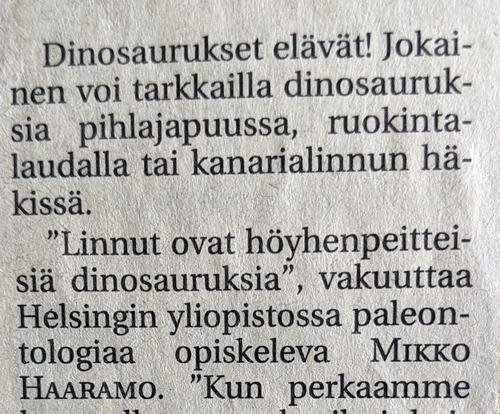
“Dinosaurs are alive! Everyone can watch dinosaurs in rowan trees in a garden, at bird feeders, or in the cage of a canary bird. ‘Birds are feathered dinosaurs’,assures Mikko Haaramo who studies paleontology at the university of Helsinki.“

“A little surprising claim about the relationship has been able to be proved in the 90s. In addition seven feathered dinosaurs, or strictly speaking fossils with remnants of feathers have been found in China.“

“Maiasaurus* taking care of newly hatched babies.“ *The correct name of the animal is Maiasaura

“Apatosaurus might have lived to be a hundred years old.” On the left side of the picture you can also see Stegosaurus!

“Tyrannosaurus rex was a terrible beast, Triceratops instead was a herbivore and a herd animal.“

“The skeleton of a Tarbosaurus is incredibly old: 72 million years.”
Here’s some pictures of the brochure:


The English page “Experience the world of dinosaurs in a realistically-staged environment.
The family life of the dinosaurs is brought to life with animatronic models that sound and look life-like, complete with realistic movements. You’ll even see tiny dinosaur babies in their nest.
Four dinosaur families will tell you their stories: how they care for their young, what they eat and what dangers threaten them.
At the ehibition, you’ll walk back in time from the Jurassic Period where you’ll meet Stegosauruses, all the way to the Cretaceous Period to meet Tyrannosaurus, the most famous dino of all time.
Alongside the animatronic dinosaurs, you’ll see real dino fossils. This collection of finds from the Gobi desert in Mongolia features massive dinosaur skeletons and even small nests.“

And finally, here’s how the ehibit was advertised in television:
View this post on Instagram
A post shared by Tiedekeskus Heureka (@heurekafi) on Apr 24, 2020 at 12:16am PDT
(I hope the Instagram link works!)
#palaeoblr#tyrannosaurus#triceratops#apatosaurus#stegosaurus#maiasaura#tarbosaurus#animatronic#heureka#finland#the family life of the dinosaurs
101 notes
·
View notes
Link
The earliest dinosaur eggs were more like leathery turtle eggs than hard bird’s eggs. That’s the conclusion of a new study of fossilized dino embryos.
A team of paleontologists studied embryos from two types of dinosaurs. One came from early in dinosaur history. The other lived about 150 million years later. Both sets of eggs were enclosed by soft shells. The researchers described their findings online June 17 in Nature. It’s the first report of soft-shelled dino eggs.
Explainer: How a fossil forms
Until now, paleontologists thought that all dinosaurs laid hard eggs. Minerals such as calcite make such shells hard and help them to fossilize. But scientists couldn’t explain a lack of fossil eggs from the earliest dinosaurs. Nor did they know why tiny structures within eggshells are so different across the three main types of dinosaurs.
“This new hypothesis provides an answer to these problems,” says Stephen Brusatte. He is a paleontologist at the University of Edinburgh in Scotland. He was not involved in the work.
Further analyses of these and other dinosaur eggs suggest that hard eggshells evolved three separate times. The team thinks the long-necked sauropods, plant-eating ornithischians (Or-nuh-THISH-ee-uns) and fierce theropods each evolved their own hard shells.
58 notes
·
View notes
Text
The Top Ten Dinosaur Discoveries of 2020
https://sciencespies.com/nature/the-top-ten-dinosaur-discoveries-of-2020/
The Top Ten Dinosaur Discoveries of 2020

There’s never been a better time to be a dinosaur fan. Even in a year where fossil explorations have been curtailed because of the COVID-19 pandemic, paleontologists have dug deep to describe dozens of new species and unlock new secrets about our favorite prehistoric creatures. The discoveries continue even now, with the fluffy “maned” dinosaur Ubirajara named just last weekend. As we anticipate what the fossil record might reveal in 2021, here’s a look back at ten dinosaur discoveries that surprised and enthralled dinosaur enthusiasts this year.
Tiny Fuzzball Shows How Dinosaurs Started Small

Life restoration of Kongonaphon kely, a newly described reptile near the ancestry of dinosaurs and pterosaurs
(Illustration by Alex Boersma)
Some of the key traits that allowed dinosaurs to be such an evolutionary success story—from fuzzy feathers to warm-running metabolisms—may have first evolved in their tiny ancestors. This year experts reported the discovery of a tiny reptile from the Triassic of Madagascar they named Kongonaphon. While not a dinosaur itself, this animal was close to the ancestors of both dinosaurs and related flying reptiles called pterosaurs. This small, insect-eating reptile likely moved nimbly to catch lunch and may have sported a coat of fuzz to help regulate its body temperature. This hints that some key dinosaur traits, such as warm-bloodedness and insulating body coverings, evolved early in their history and were elaborated upon as dinosaurs eventually diversified into all sorts of shapes and sizes.
Winner By a Tail

Spinosaurus used its tail to swim
(Gustavo Monroy-Becerril CC BY-SA 4.0 )
Paleontologists have long suspected that the giant carnivore Spinosaurus spent much of its time around the water. Fossils reported in 2015 went a step further—flat feet and dense bones indicated that Spinosaurus spent a great deal of time in the water and is the first known semi-aquatic dinosaur. This year, a tail added another clue. The appendage, found at the same quarry as the 2015 skeleton, is long and deep. The tail is more like a paddle than what’s seen in other carnivorous dinosaurs and would have been suited to swishy, side-to-side motions that propelled Spinosaurus through the water. The fact that the tail goes with the other fossils found at the site also confirm that they all go to one individual, underscoring the fact that Spinosaurus had strange body proportions unlike any other dinosaur yet discovered.
Dinosaurs Suffered From Cancer, Too

A Centrosaurus skeleton in the mass dearth assemblage at the Royal Tyrrell Museum
(Riley Black)
Dinosaurs are often celebrated for being big, fierce and tough. The truth, however, is that they suffered from many of the same injuries and maladies that humans do. A study published this year in The Lancet reported on the first well-documented case of malignant bone cancer in a non-avian dinosaur. The animal, a horned dinosaur known to experts as Centrosaurus, probably coped with declining health before its eventual death in a coastal flood that caught its herd off-guard.
Dinosaurs Weren’t in Decline When the Asteroid Hit

A Tyrannosaurus rex holotype at the Carnegie Museum of Natural History
(ScottRobertAnselmo CC BY-SA 3.0)
If dinosaurs “ruled the Earth” for millions of years, why were they hit so hard by the mass extinction of 66 million years ago? Paleontologists have been puzzling over this question for decades, and, some have suggested, dinosaurs might have already been dying back by time the asteroid struck. But an increasing amount of evidence contracts that view, including a study published this year in Royal Society Open Science. The researchers looked at different evolutionary trees for what dinosaurs were around during the end of the Cretaceous to track whether dinosaurs were dying out, thriving or staying the same. After sifting through the data, the paleontologists didn’t find any sign that dinosaurs were declining before the asteroid strike. In fact, dinosaurs seemed perfectly capable of evolving new species. If the asteroid had missed, the Age of Dinosaurs would have continued for a very long time.
Taking a Long Swim
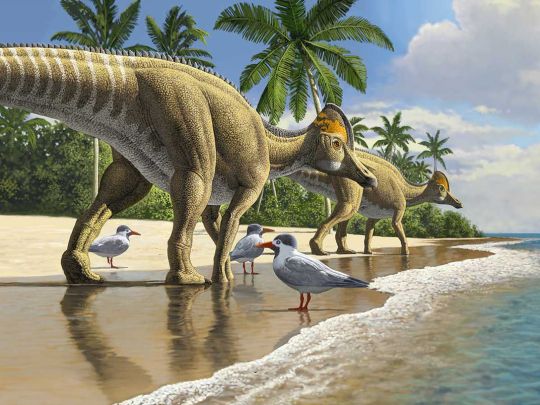
Researchers found the remains of a duckbilled dinosaur in Morocco.
(Raul Martin)
Sometimes dinosaurs show up where we don’t expect them. While paleontologists have found numerous fossils of duckbilled dinosaurs at spots around the world—from North America to Antarctica—no one had ever found one in Africa. That changed this year. In a Cretaceous Research study, paleontologists described a new species of hadrosaur found in Morocco. Named Ajnabia, the dinosaur lived at the end of the Cretaceous during a time when Africa was separated from other continents by deep water channels. Swimming would have been the only way for the dinosaur to reach prehistoric Africa from Europe or Asia, reinforcing the idea that exceptional events can help species move between distant continents.
Baby Titans Had Tiny Horns

A titanosaur embryo was discovered perfectly preserved inside its egg.
(University of Manchester)
Baby dinosaurs are exceptionally rare. We know far more about the adults of most species than how they started life. And when we do find those babies, they often hold surprises. An embryo of a long-necked dinosaur called a titanosaur reported in Current Biology drew attention this year for a strange, rhino-like horn jutting from its face. No such structure has been found in adult titanosaurs, and so it seems the horn is a kind of a temporary “egg tooth” that the dinosaur would have used to crack out of its shell.
Were Dinosaur Eggs Soft?

Protoceratops laid leathery eggs.
(AntoninJury CC BY-SA 4.0)
Think of a dinosaur egg and you’re likely to envision something out of Jurassic Park—a hard-shelled capsule the baby dinosaur has to kick or push its way out of. But research published this year in Nature proposes that many dinosaurs laid soft-shelled eggs. Under close examination, the eggs of the dinosaurs Protoceratops and Mussaurus turned out to be more like the leathery eggs of turtles than the thick, hard-shelled eggs known from other dinosaurs. This may indicate that dinosaur eggs started off soft and only later evolved to be hard-shelled in some groups. The findings may often indicate why eggs have been so hard to find for many dinosaur species, as softer eggs would decay more readily than hard-shelled ones.
Enter the Wonderchicken
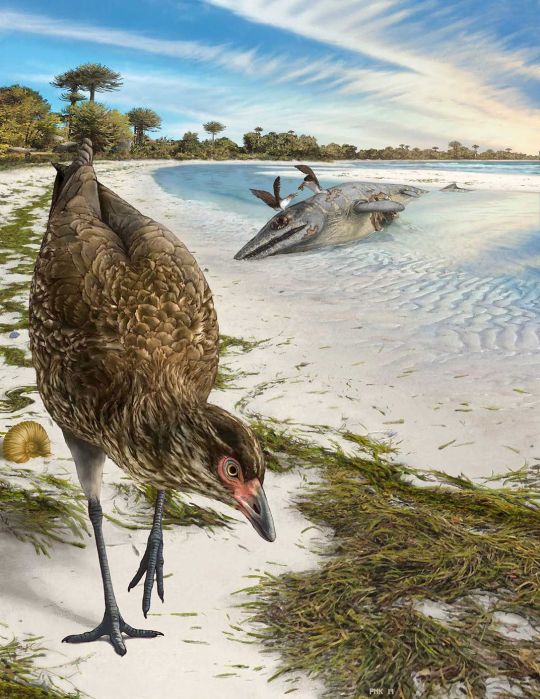
Artist’s reconstruction of the world’s oldest modern bird, Asteriornis maastrichtensis, in its original environment
(Phillip Krzeminski)
Not all this year’s big dinosaur discoveries had to do with non-avian dinosaurs. A fossil dubbed the “wonderchicken” in Nature has helped paleontologists understand how modern birds took off during the Age of Dinosaurs. While birds go back to about 150 million years ago, the wonderchicken—or Asteriornis—lived about 67 million years ago and is the oldest known representative of what biologists think of as modern birds. The fossil, which includes a skull, has some anatomical similarities to chickens and ducks. These findings indicate that modern birds started to evolve and proliferate prior to the mass extinction that wiped out the non-avian dinosaurs. If such beaked, seed-eating birds had not evolved, dinosaurs might have been entirely wiped out instead of leaving birds behind.
The Hunt for Dino DNA
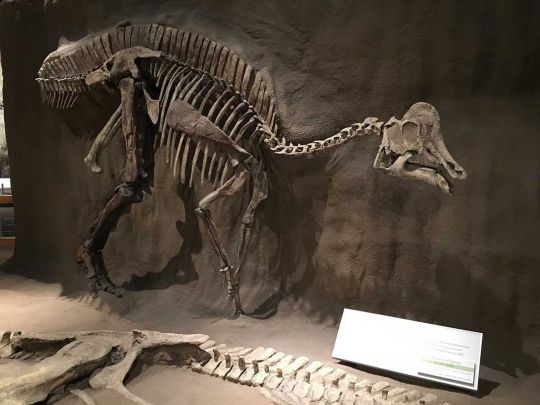
Hypacrosaurus was a 70 million-year-old hadrosaur.
(Riley Black)
Will DNA from the likes of Tyrannosaurus ever be found? The consensus has been “No,” as DNA decays too fast after death to survive millions and millions of years. But in a study published in National Science Review this year, researchers have proposed that they’ve found chemical signatures consistent with DNA in the bones of a 70 million-year-old hadrosaur called Hypacrosaurus. The results have yet to be expanded upon or verified, but the idea that even degraded DNA from non-avian dinosaurs might survive is tantalizing for all such a discovery might teach us about prehistoric life.
Polar Dinosaurs Remained Year Round

A fossil jawbone found in Alaska offers evidence that some dinosaurs stayed in polar habitats year-round.
(Andrey Atuchin)
Ever since paleontologists discovered dinosaur bones within the ancient Arctic Circle, experts have debated whether the polar dinosaurs stayed in their cool habitats year-round or migrated with the seasons. A tiny jaw from a young dinosaur now answers that question. Described in PLOS ONE, the fossil belonged to a young raptor-like dinosaur that lived in an ancient Alaskan habitat marked by harsh seasonal shifts and long, dark winters. That dinosaurs were nesting and hatching babies in these habitats indicates that they were capable of surviving the harsh winters, even when it snowed.
#Nature
5 notes
·
View notes
Text
Top 5 Minecraft Adventure Maps From 2019
And yes, I'll admit, it acquired me with a bounce scare, you jerk. Gotta squeeze in all the spooky maps I can before it turns into unwell-fitting. The Cursed Forest is a competently designed little adventure, with romps via a forest (duh) darkish tunnels, and graveyards alike. Dare I say, the lighting in Fortnite is simply so dang good (especially on Pc, after all) that it makes even newbie maps just a bit more terrifying. Yep, you are studying that proper. Someone went and Fortnite'd the Spencer Mansion from Resident Evil. You begin out in the woods and are forced to flee from a gang of Fortnite zombies, straight into the mansion itself, just like RE1 intro. It's far from a 1:1 recreation, however I discovered myself chuckling at how the structure reminded me of the early phases of that basic survival horror locale. I've but to watch The 100, but I hear good issues, and this recreation of the space station that the main cast survives on appears to be like impressive as hell.
Nightly fireworks
ESL Premium Certified recreation server
Craft 20 Paintings
26 Fake trap
This RPG survival map is also known as Imperial Lands, and is massive. Although this map is not straight impressed by any one explicit fantasy world, the influences of A-List titles, such as the Morrowind collection, Oblivion, the Fallout series, and Assassin's Creed. This map spans eleven cities, eight villages, three secret empires, and over 250 quests. The quests comply with an open-world style similar to these designed by Bethesda Studios, and provide about forty hours of gameplay. There can be a useful economic system with a financial system, and jobs to earn money. Be certain not to miss the hidden roller coaster railway which gives an astoundingly long 20 minute experience. This was certainly one of the first adventure class maps to look in Minecraft, and has been a longstanding favorite ever since. It plays much like a graphical version of traditional textual content-primarily based adventure games like Zork, by dropping the participant into the center of a dungeon, with a number of signs to tell them their goal, and never much other assist. It's essential to remedy puzzles, hidden doorways and passageways, sound blocks and Minecraft's first excessive score board. It presents about 20 minutes of gameplay. 2. Deep Space Turtle Chase!
As well as, Lego launched three different units over 4 thousand items in 2016. See high 18 listing above. With 2,464 bricks, the Lego Ferris Wheel sits simply outside the largest units ever made, nevertheless, this is likely one of the cooler units I've seen in some time. If you buy separately the Lego Power Functions motor, the Ferris Wheel will turn. With 2,996 bricks, the Lego Shield Helicarrier is the set for 2015. Minifigs included in this set are, Lego Nick Fury, Black Widow, Captain America, Hawkeye, and Maria Hill, in addition to 12 microfigs. Rounding out Fun with Minecraft Maps are Quinjets, fighter jets, and ground assist vehicles (unsure how typically this automobile lands). With the Avengers being very popular as of late, this matches right into the Lego line. Well, I just must say, this will be a kind of classic Lego sets that every Simpson's fan will need in their assortment. At 2,523 items, that is one in all the biggest units Lego has produced. The Simpsons home consists of all the minifigs and a really detailed format.
A darkish grey means a low pillar; a light gray means a high-up pillar. This gives a Minecraft world that has the proper form, however has no features—it's made completely of clean stone. I get the options from Paul's other image. At every (x,z) coordinate I verify the color of the corresponding pixel of the characteristic image. If it is darkish inexperienced, I put a layer of grass on prime of the graceful stone. If it's dark purple, I put down a layer of stone brick. And so on. The result is a three-dimensional world that represents the information discovered on a two-dimensional map. The world we created is faithful to the original map, but it does not appear to be the actual Fort Washington of 1860. Our world only shows what the map exhibits. https://www.polygon.com/2019/11/7/20952214/minecraft-most-important-game-of-the-decade-2010 are three-dimensional constructions made from various supplies, not the uniform two-dimensional outlines proven on the map. We could characterize trees and vegetation in Minecraft if we knew the place to put them, however they don't seem to be shown on the unique map, so we don't have them in our world.
After some waiting, mostly you'll receive a dino egg. Occasionally the cultivator would explode and a Failuresaurus, a Zombie Pigman or a Creeper would spawn. Thankfully, the explosion is not going to deal any harm to you or to any close by block. The cultivator as a substitute would leave in its place a block of water supply. Of fear it breaks, it is steered to set a hopper under round two blocks from the system in order that when the culture vat blows up, the dropped objects could be caught. Now for the DNA is what you obtain when you place a bio-fossil, frozen meat, or regular meat in an analyzer. When you put the DNA in a cultivator you will get either a dino egg or an embryo. DNA (any kind) is needed to craft a Dinopedia. An analyzer is a specific block which is the fundamental element to make every thing else in the mod. It necessitates a relic, a bio fossil and 4 iron.
1 note
·
View note
Photo
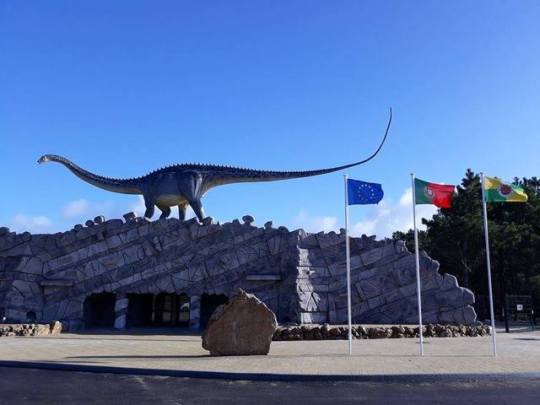

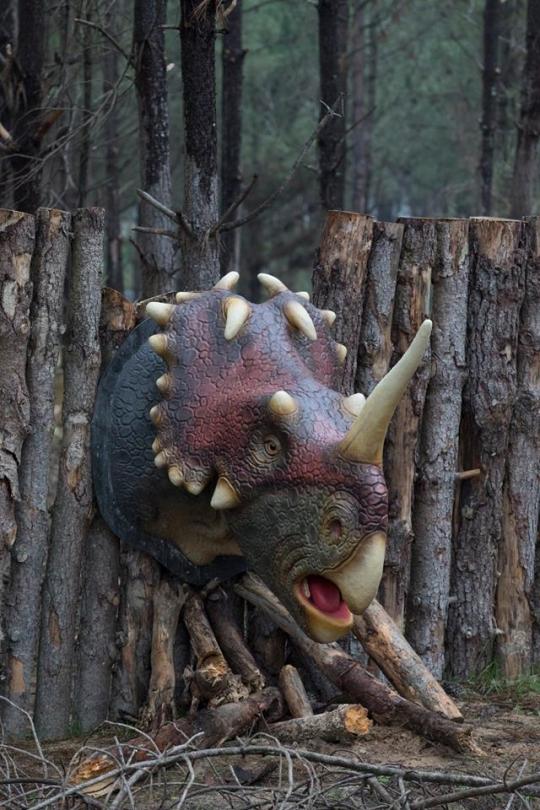

Village of the giants
Dinosaurs came into my life when I was very young (I wasn’t even able to read or write by then). I discovered them through a big old book that belonged to my father and the illustrations that I saw left me fascinated to this day and I never stopped being in love with these creatures. I cannot tell you how many times I imagined how cool it would be to see a real dinosaur, Jurassic Park style, but without the fatalities, of course. Although Jurassic Park is not a reality, here’s an alternative: Dino Parque da Lourinhã (Dino Park). The portuguese Dino Park was created with the cooperation between the Municipality of Lourinhã and the german Münchenhagen’s Dinosaurierpark. It is located in Lourinhã, a village that is 45 minutes away from Lisbon. It is basically an outdoor museum with an area of 10 hectares that includes 4 tracks from the end of the Paleozoic, the Triassic, the Jurassic and the Cretaceous. The cool thing about these tracks is that you get to observe over 120 models of dinosaurs (and other animals) on a real scale. Beside the tracks, you can visit the main central building which grants access to the museum of Lourinhã. The exhibition displayed here includes a great collection of paleontologic discoveries and there is also a laboratory on which visitors can observe the preparation of fossils in real time, or the assemblage of complete skeletons.
Let’s focus on the outside, for a bit. The dinosaur models are obviously the Dino Park’s greatest feature. The models were built on a real scale, considering the latest discoveries and with the cooperation with scientists from around the globe. Visitors can expect to see the well known Triceratops or the infamous T-rex, but also local dinosaurs, such as the Torvosaurus gurneyi (the biggest carnivore from the Jurassic, with 11m in length), the Lourinhasaurus antunesi (a carnivore dinosaur, also from the Jurassic with 7-8m long) and the gigantic Supersaurus lourinhanensis and the Lourinhasaurus alenquerensis. These two sauropod species were so large that it was not possible for a lone predator to hunt them.
The museum, as mentioned above, presents an exhibition based on fossil discoveries from the Lourinhã area. This region is located in one of the richest places in Portugal with upper Jurassic fossils and it is one of the best places in the world for 150 million year old findings. This happens because back then, Lourinhã was a huge valley with water courses, which attracted a multitud of animals, including our beloved dino friends and even the first mammals. The conditions in this area were determinant to obtain fossils of exceptional quality.
Lourinhã is well known for its fossils, but also ichnofossils - there are plenty of dinosaur footpring trails, footprints with skin details, stomach stones and if this wasn’t enough, there are intact eggs with embryos! This is quite amazing, specially since eggs are incredibly hard to preserve. But despite that, this region has several egg laying locations that belong to the huge Lourinhasaurus.
I have this place in my bucket list and I am hoping to check it from my list within a couple of months. If this is a place that you would like to visit, you should also know that the Dino Park offers guided visits for those who seek a more complete experience. And since this place was created having in consideration the concept of Edutainment (Education + Enternainment), there are also plenty of activities for visitors from all ages. Just to name a couple, there is the possibility of receiving a rock with roughly 50 million years (curiously, the rocks come from Wyoming, USA) and you get to prepare it under the supervision from someone from the staff. There is a chance that you find a small animal or plant and you can take home with you your finding. Another interesting activity is the opening of a geode (from Morocco or Tunisia) with a proper hammer and unveil the pretty inside. You don’t get to do stuff like this everyday, so it is a great opportunity.
Dino Park is undoubtedly a place to further nourish our love of dinosaurs.
Su
Sources: http://bit.ly/2BZHIpE
Photo credits: all photos are courtesy of Dino Parque with thanks to Mr. Tiago Marques
#Dino parque#dinosaur#dinosaur park#dino park#nature#rock#geology#paleontology#fossilfriday#the earth story#portugal
127 notes
·
View notes
Text
Early dinosaurs may have laid soft-shelled eggs
The earliest dinosaur eggs were more like leathery turtle eggs than hard bird’s eggs. That’s the conclusion of a new study of fossilized dino embryos.
A team of paleontologists studied embryos from two types of dinosaurs. One came from early in dinosaur history. The other lived about 150 million years later. Both sets of eggs were enclosed by soft shells. The researchers described their findings online June 17 in Nature. It’s the first report of soft-shelled dino eggs.
Explainer: How a fossil forms
Until now, paleontologists thought that all dinosaurs laid hard eggs. Minerals such as calcite make such shells hard and help them to fossilize. But scientists couldn’t explain a lack of fossil eggs from the earliest dinosaurs. Nor did they know why tiny structures within eggshells are so different across the three main types of dinosaurs.
“This new hypothesis provides an answer to these problems,” says Stephen Brusatte. He is a paleontologist at the University of Edinburgh in Scotland. He was not involved in the work.
Further analyses of these and other dinosaur eggs suggest that hard eggshells evolved three separate times. The team thinks the long-necked sauropods, plant-eating ornithischians (Or-nuh-THISH-ee-uns) and fierce theropods each evolved their own hard shells.
Unearthing soft dino eggs
The researchers analyzed a clutch of dinosaur eggs found in Mongolia. The eggs are thought to come from Protoceratops. That was a sheep-sized ornithischian. The fossil dates to between 72 million and 84 million years ago. The team also analyzed an egg found in Argentina. It is between 209 million and 227 million years old. Scientists believe it to be Mussaurus. It was a sauropod ancestor.
The soft eggshells weren’t easy to spot. “When they are preserved, they’d only be preserved as films,” says Mark Norell. An author of the new study, works as a paleontologist at the American Museum of Natural History in New York City. When his team examined the fossilized embryos, they noticed egg-shaped halos around the skeletons. On closer look, those halos had thin brown layers. But the layers were not evenly arranged. That suggested the material was biological, not made solely of minerals. Minerals tend to create very orderly patterns.
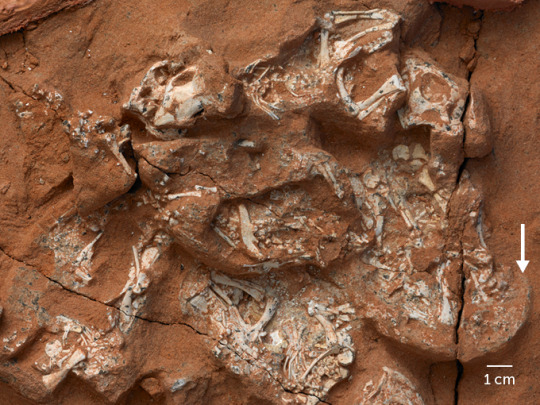
This well-preserved clutch of eggs is from Protoceratops, a plant eater that lived more than 70 million years ago. Chemical studies of its eggs show that they had soft shells. The arrow points to an embryo that still has remnants of a soft shell.M. Ellison/©AMNH
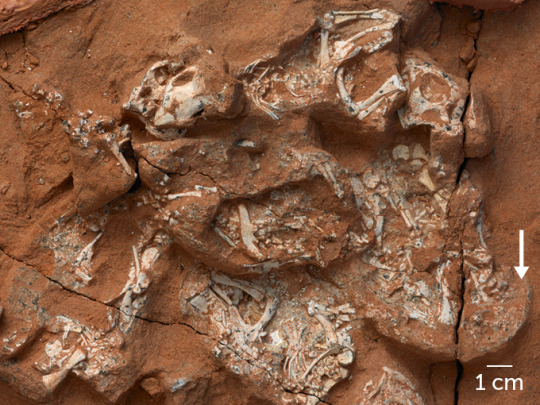
This well-preserved clutch of eggs is from Protoceratops, a plant eater that lived more than 70 million years ago. Chemical studies of its eggs show that they had soft shells. The arrow points to an embryo that still has remnants of a soft shell.M. Ellison/©AMNH
Before a few years ago, “people thought that everything that’s soft and squishy decays away immediately post mortem,” says study author Jasmina Wiemann. She is a paleontologist at Yale University in New Haven, Conn. But growing evidence suggests that soft biological material can fossilize. The right conditions can preserve soft tissues, she says.
The team used lasers to probe the chemical composition of the brown layers. They used a method that would not damage the fossils. This Raman spectroscopy shines laser light on a sample, then measures how the light bounces off. The properties of the scattered light show what type of molecules are present. Wiemann has used the approach to identify pigments in dinosaur eggs.
The researchers compared the chemical fingerprints of these fossilized eggs with those of eggs from hard-shelled dinosaur. They also compared them with eggs from present-day animals. The Protoceratops and Mussaurus eggs were most similar to modern soft-shelled eggs.
Next, the scientists combined eggshell data with what’s known about the family trees of extinct and living egg-laying animals. From that, the researchers calculated the most likely scenario for the evolution of dinosaur eggs. Early dinosaurs laid soft-shelled eggs, they determined. Hard shells evolved in later dinos. And it happened several times — at least once in each major limb of the dino family tree.
These results suggest it may be time to rethink dinosaur parenting, says Wiemann. In the past, many ideas came from studying fossils of theropods, such as T. rex. For example, some of them sat on eggs in open nests, like modern birds. But if eggs evolved separately in different lines of dinos, parental behavior may have, too.
“If you have a soft-shelled egg,” Norell says, “you’re burying your eggs. [There’s] not going to be a lot of parental care.” In some ways, he now suspects, dinosaurs that laid soft eggs might resemble early reptiles more than they do birds.
Now that paleontologists know what to look for, the search is on for more soft-shelled dino eggs. Paleontologist Gregory Erickson works at Florida State University in Tallahassee. He says, “I would not be surprised if other people come forward with other specimens.”
.image-mobile { display: none; } @media (max-width: 400px) { .image-mobile { display: block; } .image-desktop { display: none; } }
Early dinosaurs may have laid soft-shelled eggs published first on https://triviaqaweb.tumblr.com/
0 notes
Text
Early dinosaurs may have laid soft-shelled eggs
Early dinosaurs may have laid soft-shelled eggs

The earliest dinosaur eggs were more like leathery turtle eggs than hard bird’s eggs. That’s the conclusion of a new study of fossilized dino embryos.
A team of paleontologists studied embryos from two types of dinosaurs. One came from early in dinosaur history. The other lived about 150 million years later. Both sets of eggs were enclosed by soft shells. The researchers describedtheir findings…
View On WordPress
0 notes
Text
Neutron source enables a look inside dino eggs
Did the chicks of dinosaurs from the group oviraptorid hatch from their eggs at the same time? This question can be answered by the length and arrangement of the embryo’s bones, which provide information about the stage of development. But how do you look inside fossilized dinosaur eggs?
Neutron source enables a look inside dino eggs syndicated from https://triviaqaweb.blogspot.com/
0 notes
Link
The earliest dinosaur eggs were more like leathery turtle eggs than hard bird’s eggs. That’s the conclusion of a new study of fossilized dino embryos.
A team of paleontologists studied embryos from two types of dinosaurs. One came from early in dinosaur history. The other lived about 150 million years later. Both sets of eggs were enclosed by soft shells. The researchers described their findings online June 17 in Nature. It’s the first report of soft-shelled dino eggs.
30 notes
·
View notes
Text
First Soft-Shelled Dinosaur Egg Fossils Found
https://sciencespies.com/news/first-soft-shelled-dinosaur-egg-fossils-found/
First Soft-Shelled Dinosaur Egg Fossils Found
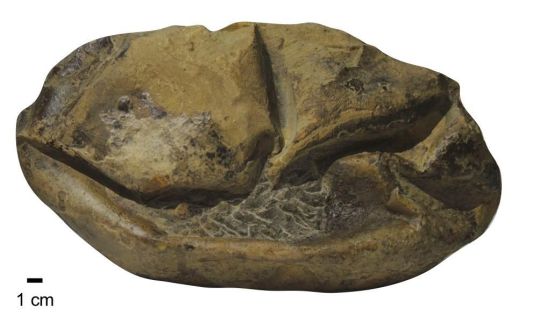
Two studies published this week in the journal Nature are upending paleontologists’ understanding of ancient reptile reproduction, reports Lucas Joel for the New York Times.
One study found evidence that some of the earliest dinosaurs laid soft-shelled eggs, and not eggs with hard shells as was previously thought. The second discovery is another soft-shelled egg that researchers have attributed to a kind of giant marine reptile called a mosasaur. The giant, nearly foot-long egg suggests mosasaurs didn’t give live birth as researchers once assumed, but instead laid leathery-shelled eggs like their closest living relatives monitor lizards and snakes.
The new evidence that some dinosaurs and their extinct reptilian contemporaries laid eggs without hard shells helps explain the rarity of eggs in the first half of the fossil record, according to the Times. Soft shells tend to rot away quickly, which would have made it less likely for them to fossilize. Both finds may have implications for the reproductive evolution of dinosaurs and ancient reptiles.
Chilean paleontologists found “The Thing” in Antarctica in 2011. It was a fossil the size of a football that had a crinkled exterior that made it look deflated. The researchers who had collected The Thing couldn’t tell what it was, reports Nell Greenfieldboyce of NPR. But when paleontologist Julia Clarke of the University of Texas at Austin saw its rumpled surface, she knew just what she was looking at.

A side view of the fossil of the giant soft-shelled egg found in Antarctica.
(Legendre et al. 2020)
It was a giant, soft-shelled egg, and it was also 66 million years old, the researchers report this week in Nature. No fossilized embryo or hatchling was available to positively identify what creature produced it. The researchers arrived at their suggestion that it came from a mosasaur based on the fossil egg’s size, shape and the fact that mosasaur remains were found nearby. The team estimates the mosasaur that laid the egg was more than 20 feet long, without including its tail, according to a statement from the University of Texas at Austin (UTA).
The find represents the first fossil egg ever found in Antarctica, the largest known soft-shelled egg and the second largest egg ever known to have existed, according to the UTA statement. The massive size of the egg also challenges assumptions about how big eggs with soft shells can get before collapsing, Lucas Legendre, a paleontologist at UTA and the study’s lead author, tells the Times.
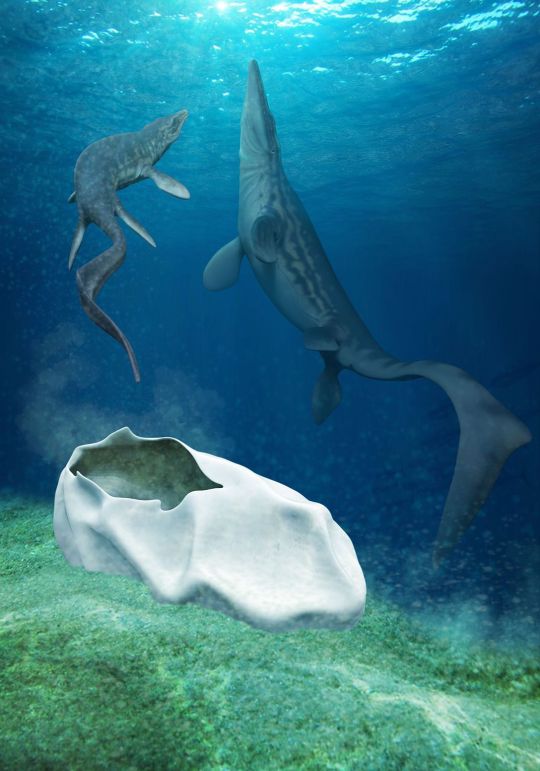
An artist’s interpretation of a baby mosasaur emerging from an egg in ancient Antarctic waters.
(Francisco Hueichaleo)
Paleontologists don’t know for sure the egg came from a mosasaur. And in light of the other newly published paper documenting soft-shelled eggs in dinosaurs for the first time, the intriguing possibility exists that the giant ovum was produced by a dinosaur and somehow washed out to sea.
The first dinosaur eggs were found in the 1800s. Paleontologists went on to find communal nests and evidence of brooding that made dinosaur parents seem much like the creatures that are some of their closest living relatives: modern birds, write archaeologists Johan Lindreg of Lund University and Benjamin Kear of Uppsala University in a commentary published along with the new research.
As our understanding of dinosaur eggs deepened, so did certain inconsistencies. Most of the dino-eggs paleontologists uncovered were from the Cretaceous—which lasted from 66 million to 145 million years ago—leaving a more than 100-million-year gap in the fossil record during the Triassic and Jurassic periods, according to the commentary. The bulk of the eggs also came from a suspiciously small number of dinosaur groups.
“Over the last 20 years, we’ve found dinosaur eggs around the world. But for the most part, they only represent three groups—theropod dinosaurs, which includes modern birds, advanced hadrosaurs like the duck-bill dinosaurs, and advanced sauropods, the long-necked dinosaurs,” says Mark Norell, paleontologist at the American Museum of Natural History and lead author of the study, in the statement from the museum. “At the same time, we’ve found thousands of skeletal remains of ceratopsian dinosaurs, but almost none of their eggs. So why weren’t their eggs preserved? My guess—and what we ended up proving through this study—is that they were soft-shelled.”

Protoceratops eggs found in Mongolia’s Gobi Desert.
(M. Ellison/American Museum of Natural History)
The research that confirmed Norell’s hunch describes eggs from two different species of plant eating dinosaurs, per NPR. The twin finds come from Protoceratops, a sheep-sized relative of the more famous Triceratops that lived between 71 million and 145 million years ago, and Mussaurus, a long-necked dinosaur about 20 feet long that lived between 208.5 million and 227 million years ago, per the museum’s statement.
The Protoceratops fossil was a clutch of embryos found in Mongolia in the 90s, reports Michael Greshko of National Geographic. The embryos were all early enough in their development that the absence of hard egg shells from the fossil was conspicuous. Similarly, expeditions in 2012 and 2013 to Argentina unearthed a group of Mussaurus embryos that had no sign of calcified eggshells nearby, according to National Geographic.
The recognition that the fossils contained the remnants of soft-shelled eggs came from chemical analysis prompted by strange haloes surrounding the embryos, according to the Times. Molecular paleobiologist Jasmina Wiemann of Yale University compared the chemical composition of these haloes surrounding the fossil embryos to that of modern hard and soft-shelled eggs and found the chemical fingerprint of the fossils matched the eggs with soft shells, she tells the Times.
Finding out that some dinosaur groups laid soft-shelled eggs also explains puzzling differences that paleontologists have noted in the surfaces of previously discovered hard-shelled eggs, write Lindreg Kear in their commentary. Instead, Norell and his colleagues suggest that hard-shelled eggs evolved at least three times in separate lineages.
“The dinosaur calcified egg is something that is not ancestral, that is not sort of a primitive feature of all dinosaurs,” Wiemann tells NPR.
The soft-shell revelation also suggests that many dinosaurs buried their eggs like some modern reptiles, since soft shells lose moisture quickly and couldn’t withstand the weight of a brooding parent.
“The idea that the ancestral dinosaur laid soft-shelled eggs like a turtle is a bold hypothesis, but I like it,” Stephen Brusatte, a paleontologist at the University of Edinburgh who was not involved in the study, tells the Times. “It’s a stunning revelation—and it’s remarkable to think of these giant dinosaurs, larger than buses and in some cases airplanes, starting out as little pipsqueaks tearing their way out of a soft egg.”
#News
2 notes
·
View notes